
4 | English
1 609 92A 1UE | (16.1.17) Bosch Power Tools
Safety Warnings for Angle Grinder
Safety Warnings common for Grinding, Sanding,
Wire Brushing or Abrasive Cutting Off Operations
This power tool is intended to function as a grinder,
sander, wire brush or cut-off tool. Read all safety warn-
ings, instructions, illustrations and specifications pro-
vided with this power tool. Failure to follow all instruc-
tions listed below may result in electric shock, fire and/or
serious injury.
Operations such as polishing are not recommended to
be performed with this power tool. Operations for which
the power tool was not designed may create a hazard and
cause personal injury.
Do not use accessories which are not specifically de-
signed and recommended by the tool manufacturer.
Just because the accessory can be attached to your power
tool, it does not assure safe operation.
The rated speed of the accessory must be at least equal
to the maximum speed marked on the power tool. Ac-
cessories running faster than their rated speed can break
and fly apart.
The outside diameter and the thickness of your acces-
sory must be within the capacity rating of your power
tool. Incorrectly sized accessories cannot be adequately
guarded or controlled.
Threaded mounting of accessories must match the grind-
er spindle thread. For accessories mounted by flanges,
the arbour hole of the accessory must fit the locating di-
ameter of the flange.
Accessories that do not match the
mounting hardware of the power tool will run out of balance,
vibrate excessively and may cause loss of control.
Do not use a damaged accessory. Before each use in-
spect the accessory such as abrasive wheels for chips
and cracks, backing pad for cracks, tear or excess
wear, wire brush for loose or cracked wires. If power
tool or accessory is dropped, inspect for damage or in-
stall an undamaged accessory. After inspecting and in-
stalling an accessory, position yourself and bystanders
away from the plane of the rotating accessory and run
the power tool at maximum no-load speed for one min-
ute. Damaged accessories will normally break apart during
this test time.
Wear personal protective equipment. Depending on
application, use face shield, safety goggles or safety
glasses. As appropriate, wear dust mask, hearing pro-
tectors, gloves and shop apron capable of stopping
small abrasive or workpiece fragments. The eye protec-
tion must be capable of stopping flying debris generated
by various operations. The dust mask or respirator must be
capable of filtrating particles generated by your operation.
Prolonged exposure to high intensity noise may cause
hearing loss.
Keep bystanders a safe distance away from work area.
Anyone entering the work area must wear personal
protective equipment. Fragments of workpiece or of a
broken accessory may fly away and cause injury beyond
immediate area of operation.
Hold the power tool by insulated gripping surfaces on-
ly, when performing an operation where the cutting ac-
cessory may contact hidden wiring or its own cord. Cut-
ting accessory contacting a “live” wire may make exposed
metal parts of the power tool “live” and could give the op-
erator an electric shock.
Position the cord clear of the spinning accessory. If you
lose control, the cord may be cut or snagged and your hand
or arm may be pulled into the spinning wheel.
Never lay the power tool down until the accessory has
come to a complete stop. The spinning wheel may grab
the surface and pull the power tool out of your control.
Do not run the power tool while carrying it at your side.
Accidental contact with the spinning accessory could snag
your clothing, pulling the accessory into your body.
Regularly clean the power tool’s air vents. The motor’s fan
will draw the dust inside the housing and excessive accumu-
lation of powdered metal may cause electrical hazards.
Do not operate the power tool near flammable materi-
als. Sparks could ignite these materials.
Do not use accessories that require liquid coolants. Us-
ing water or other liquid coolants may result in electrocu-
tion or shock.
Kickback and related warnings
Kickback is a sudden reaction to a pinched or snagged rotat-
ing wheel, backing pad, brush or any other accessory.
Pinching or snagging causes rapid stalling of the rotating ac-
cessory which in turn causes the uncontrolled power tool to
be forced in the direction opposite of the accessory’s rota-
tion at the point of the binding.
For example, if an abrasive wheel is snagged or pinched by
the workpiece, the edge of the wheel that is entering into the
pinch point can dig into the surface of the material causing
the wheel to climb out or kick out. The wheel may either
jump toward or away from the operator, depending on di-
rection of the wheel’s movement at the point of pinching.
Abrasive wheels may also break under these conditions.
Kickback is the result of power tool misuse and/or incorrect
operating procedures or conditions and can be avoided by
taking proper precautions as given below.
Maintain a firm grip on the power tool and position your
body and arm to allow you to resist kickback forces. Al-
ways use auxiliary handle, if provided, for maximum
control over kickback or torque reaction during
start-up. The operator can control torque reactions or
kickback forces, if proper precautions are taken.
Never place your hand near the rotating accessory. Ac-
cessory may kickback over your hand.
Do not position your body in the area where power tool
will move if kickback occurs. Kickback will propel the
tool in direction opposite to the wheel’s movement at the
point of snagging.
Use special care when working corners, sharp edges,
etc. Avoid bouncing and snagging the accessory. Cor-
ners, sharp edges or bouncing have a tendency to snag the
rotating accessory and cause loss of control or kickback.
OBJ_BUCH-1474-005.book Page 4 Monday, January 16, 2017 11:11 AM

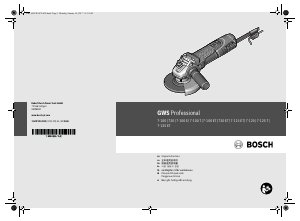


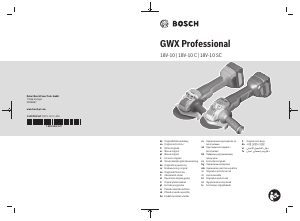
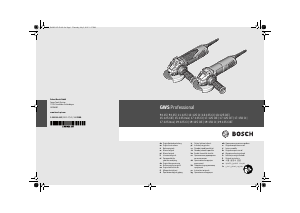
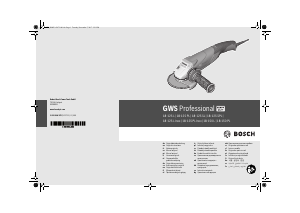
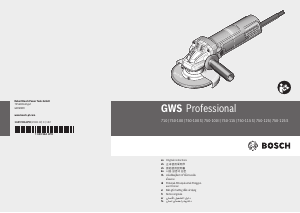
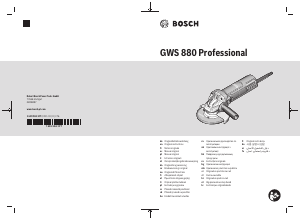
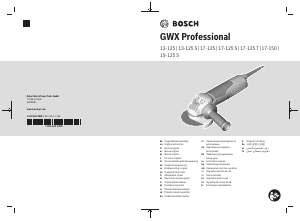
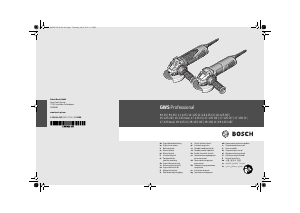
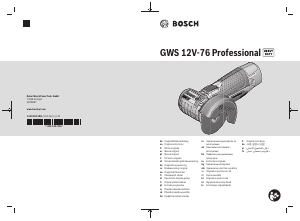
이 제품에 대한 대화 참여
여기서 보쉬 GWS 7-115 ET Professional 앵글 그라인더에 대한 귀하의 생각을 공유할 수 있습니다. 궁금한 점이 있으면 먼저 설명서를 주의 깊게 읽어보세요. 매뉴얼 요청은 문의 양식을 사용하여 수행할 수 있습니다.